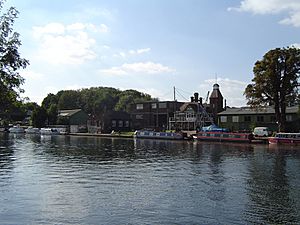Platt's Eyot facts for kids
Quick facts for kids Platt's Eyot |
|
|---|---|
 Port Hampton on Platt's Eyot |
|
| OS grid reference | TQ133691 |
| • Charing Cross | 12.5 mi (20.1 km) ENE |
| London borough | |
| Ceremonial county | Greater London |
| Region | |
| Country | England |
| Sovereign state | United Kingdom |
| Post town | HAMPTON |
| Postcode district | TW12 |
| Dialling code | 020 |
| Police | Metropolitan |
| Fire | London |
| Ambulance | London |
| EU Parliament | London |
| UK Parliament |
|
| London Assembly |
|
Platt's Eyot (sometimes called Platt's Ait) is a cool island in the River Thames. You can find it in Hampton, which is part of the Richmond upon Thames in England. It sits between two river locks: Molesey Lock and Sunbury Lock.
Contents
About Platt's Eyot
Island Geography
Platt's Eyot started as a typical river ait. These small islands were often used for growing willow trees, called osiers. Over time, soil and sand from digging out the Stain Hill Reservoirs were added to the island. This created a big hill on the western side of the island.
Today, a special bridge connects the island to Hampton. The whole island is important for nature. It's listed as a "River Thames site of Metropolitan Importance for Nature Conservation." The western part of the island is also part of the Metropolitan Green Belt, which helps protect green spaces around London. Platt's Eyot is the most western island on the River Thames in Greater London.
A Look Back in Time (History)
The island gets its name from a person named Platt, who came from Molesey. Platt used the island to grow willow trees.
Boatbuilding Begins
Boatbuilding started on Platt's Eyot in 1868. A man named Thomas Tagg, who already had a boat business nearby, built a boatyard and a house on the eastern side of the island. Later, a waterworks and an electrical station were also built there. The electrical station was used to charge electric boats and canoes made on the island.
Around 1904, John Isaac Thorneycroft set up the Hampton Launch Works on the island. This was a branch of his main boatyard in Chiswick. The Platt's Eyot yard focused on building cabin cruisers and speedboats. Thorneycroft's success on the island led to big contracts from the Admiralty, which is like the navy's main office.
Building for War Efforts
Because of these contracts, a new, larger boatyard was built in Southampton. This became Thorneycroft's main yard. However, the Platt's Eyot yard kept working during both the First World War and the Second World War. It built smaller naval boats for the war effort.
During the First World War in 1916, the Admiralty asked Thorneycroft to build a new type of fast boat that could carry torpedoes. Thorneycroft secretly built these boats at the Platt's Eyot facility. Four new boat sheds were built on the island around this time. These sheds were designed by Augustine Alban Hamilton Scott. They used a special building method called the "Belfast truss" system. This system was developed during the First World War to roof wide buildings like aircraft hangars. Not many boat sheds were built this way, and these ones are now considered important historical buildings.
During the Second World War, the boatyard was used to build motor torpedo boats, motor launches, and landing craft. Thorneycrofts stopped its boatbuilding work on Platt's Eyot in the mid-1960s. In 1960, a company called Port Hampton Ltd. bought the island. They started using the industrial spaces for different things.
Island Connections
In 1941, the island was connected to the Hampton bank of the River Thames by a suspension bridge. This bridge was put together by the Royal Engineers.
On April 1, 1970, the island officially moved from Esher Urban District in Surrey to the London Borough of Richmond upon Thames in Greater London. This change happened because of a law called the London Government Act 1963.
In recent years, several music recording studios have opened on the island.


